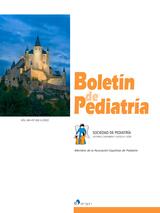Características de los debuts diabéticos en los niños ingresados en un hospital terciario durante diez años
A.N. Fernández Rodríguez , L. Regueras Santos , J.P. Martínez Badás
Bol. Pediatr. 2022; 62 (260): 111 - 118
Introducción. La diabetes mellitus tipo 1 constituye una de las patologías crónicas más frecuentes en la infancia. Su incidencia está sufriendo un incremento en los últimos años. Objetivo. Describir y analizar las características epidemiológicas, clínicas, analíticas y terapéuticas en el momento del debut de la enfermedad, comparándolas entre grupos de edad de los pacientes que debutan con DM1 en nuestra provincia. Pacientes y métodos. Estudio observacional retrospectivo mediante revisión de historias clínicas de pacientes menores de 14 años con debut de diabetes tipo 1 entre 2007 y 2017 en un hospital de tercer nivel. La muestra se dividió por edades en tres grupos (0-4 años, 5-9 años,10-14 años). Resultados. Se recogieron 64 pacientes con edad media de 8,15 años (DE 3,41), el 48,4% entre 5-9 años. No se hallaron diferencias de sexo ni patrón estacional, aunque los pacientes de menor edad debutaron más frecuentemente en invierno. No se observó aumento en la incidencia con el tiempo ni diferencias en los síntomas entre grupos. Debutaron con cetoacidosis diabética el 36%, fundamentalmente leves. Encontramos un porcentaje menor de anticuerpos IAA y antiGAD de lo esperado y mayor frecuencia de antecedentes familiares positivos. Se observó correlación lineal positiva entre las cifras de bicarbonato y cuerpos cetónicos en sangre y las necesidades de insulina por kg de peso (p 0,025 y p 0,05, respectivamente). Los niños de menor edad presentan niveles de HbA1c más bajos al inicio de la enfermedad. Conclusiones. En nuestro medio no se está produciendo un aumento en el número de casos de esta enfermedad, aunque los mismos se concentran a menor edad de la esperada.
Characteristics of diabetes onset in children hospitalised in a tertiary hospital during ten years
Introduction. Type 1 diabetes mellitus is one of the most frequent chronic pathologies in childhood. Its incidence has increased in the last years. Objective. To analyze the epidemiological, clinical, analytical and therapeutic characteristics at the time of the disease’s onset, and to compare them between age groups of those patients with Diabetes mellitus type 1 in our region. Patients and methods. Retrospective observational study by reviewing the medical records of patients under 14 years of age with onset of type 1 diabetes between 2007 and 2017 in a tertiary-level hospital. The sample was divided by age into three groups (0-4 years, 5-9 years,10-14 years). Results. 64 patients were studied, the mean age was 8.15 years (SD 3.41), 48.4% of them between 5-9 years. No differences in sex or seasonal pattern were found, although younger children became ill more frequently in winter. There was no increase in incidence over time ordifferences in symptoms between groups. 36% debuted with diabetic ketoacidosis, mainly mild. We found a lower percentage of IAA and antiGAD antibodies than expected and a higher frequency of positive family history. A positive linear correlation was observed between the levels of bicarbonate and ketone bodies in blood and the insulin needs per kg of weight (p 0.025 and p 0.05 respectively). Younger children have lower HbA1c levels at the beginning of the disease. Conclusions. In our centre there is not an increase in the number of cases of this disease, although we found more cases at a younger age than expected.
Artículo completo (PDF) (134 kb.)
- Endocrino-Metabolismo
Buscar en el boletín
Año 2022, Volumen 62, Número 260

Boletín completo en PDF (8748 kb.)